Anywhere you stand in Lithuania’s Old Town Vilnius, you can see the spires of at least three churches. For a nation once under the Soviet Union’s hammer and sickle, the number of ancient cathedrals that survived is amazing — in part the result of its remote location, the southernmost nation in the trinity of Lithuania, Latvia and Estonia that make up the Baltic States.
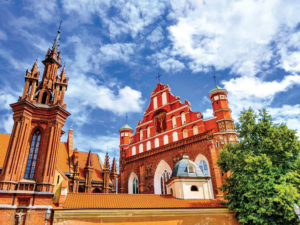
At the moment, my family and I stood in Cathedral Square, the neoclassical Vilnius Cathedral in front of us, its separate belfry (which we’d just climbed and descended) looming next to us like a stone rocket ready to take off.
Between us, the stebuklas: a tile in the stone square marking the end point of the “human chain” and the ensuing end to Soviet occupation for the Baltic people. In August 1989, two million Baltic citizens held hands in a line stretching from this very point, through Riga, the capitol of Latvia, and into a corresponding point in Tallinn, capitol of Estonia. The longest human chain in history sparked independence for the three nations.
Surrounded by the marvels of Cathedral Square — Vilnius Cathedral, the Lower and Upper Castles, the National Museum of Lithuania — this modest marker, despite appearance, was perhaps the most significant.
Between a Rocker and a Hard Place
Not far from Cathedral Square stands the KGB Museum and Prison, alternately called the Museum of Genocide Victims or Museum of Occupations and Freedom Fights. This former gymnasium became the headquarters of the Gestapo during Nazi occupation, then of the KGB during Soviet reign. The museum showcases KGB artifacts from spy cameras to listening devices. The basement bone-chillingly preserves the KGB prison and execution chamber as it was when still active in 1991.
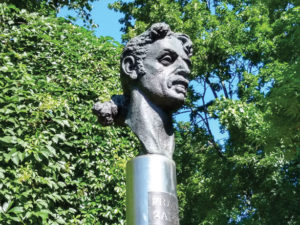
The nearby Frank Zappa Memorial was a test of Lithuania’s freedom as much as a tribute to the California rocker from Baltimore. After the fall of communism, local artists tested the limits of their newfound freedom by commissioning the bust of an American rock star by a sculptor known for his communist monuments.
Vilnius presented Baltimore with a replica in 2010, which stands before the Enoch Pratt Free Library’s Southeast Anchor Branch.
Castle on an Island
Takai, a half-hour from Vilnius, is a small community of about 5,000 residents founded by Lithuanians, Russians, Poles, Jews, Tatars and Karaims — a melting pot predating the one we know in America. At the center of the community is the Trakai Island Castle. We arrived early and found it relatively tourist-free. After a private cruise across Lake Galvė and around the island, we toured the castle’s interior, defense towers and the museum exhibits with armor and weaponry, medallions and excavation finds.
As late-morning visitors descended onto the castle, we made our escape to enjoy a leisurely stroll around the castle and along the lake shore. Kiosks sold kvass, a fermented rye bread drink that tastes like something between an ale and a soda, and homemade pocket pies stuffed with cabbage and pork and mushroom. The kids seemed most interested in the šakotis, a crisp cake cooked on a rotating spit over an open fire, resembling a Christmas tree when stood on end.
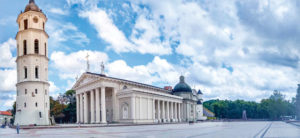
There were handicrafts, too, offered by local artisans and artists, from pottery to wooden carvings: bowls and vases, spoons and spatulas, statues and figurines. A local artist demonstrated how she made her hot pads and coasters with a combination of hand-carved wood and fresh-cut cross-sections of dried herb and grass bunches. The result was a beautiful floral pattern that was as pleasing to the nose as to the eye, the potpourri smell intensifying when a hot dish sat upon it.
As we slowly made our way along the winding path of kiosks and vendors, local arts and flavors, the lake and the castle emerging from its center remained in view. The peddlers gave way to country houses as we caught the bus to Vilnius.
A Hearty Diet
There was no shortage of traditional Lithuanian cuisine in Vilnius, although a vegetarian or vegan may need to be more diligent than the average traveler. Potatoes and pork seem to be at the heart of the diet with healthy servings of game, mushrooms and herring.
Lithuanian soups can make hearty meals themselves. My wife Nataliya’s favorite was a mushroom soup; mine was a sour rye bread soup — both served in homemade black bread bowls. Our children, Alex and Nicole, gravitated to somewhat more American-like pork and potato dishes.
At Aline Leiciai, an Old Town restaurant, we enjoyed Lithuania’s national dish: cepelinai, or zeppelins, called so due to their blimp shape. These potato dumplings are made with grated and riced potatoes, often stuffed with meat or cheese, and they have an almost gummy texture. It was one of the more unique and tasty dishes we tried.
With its rustic Baltic beer hall decor, complete with weathered benches, chairs and tables, the dining hall and outdoor seating at Aline Leicia matched the food. Another favorite here were the potato pancakes, more like hash browns, really, which were grated fresh and made to order. The Lithuanian craft beer was a great way (for the grown-ups) to wash it down.
Art(illery) and Politics
The museums in Vilnius provide a filling itinerary. The National Gallery of Art highlights Lithuanian art, the National Museum offers a look at Lithuanian life through the centuries, and the Applied Arts Museum exhibits items relating to the Grand Duchy and sacred art such as wooden shrines, saints and crosses.
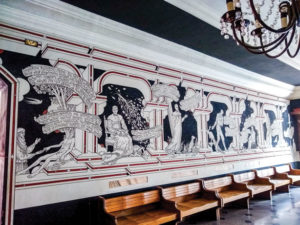
Peace and independence seem secure these days, but in the 1700s, the Vilnius Artillery Bastion was essential to the old town’s defense. Now it’s an impressive museum with deep, underground hallways and a clay roof that nearly touches the ground.
Back in Town Square, on the neoclassical Town Hall, a brass sign displays a quote from George W. Bush: “Anyone who would choose Lithuania as an enemy has also made an enemy of the United States of America.”
A local chuckled as we stood reading the quote. “Our country was so proud
of that,” she said. “Then we found out it was issued to all allied countries.
Like spam.” All the same, they made President Bush an honorary citizen.
Game for New Things
Although Vilnius features modern shopping malls and centers, we prefer to happen upon the smaller, more traditional and often family-owned shops and kiosks. There are plenty of those along Palace and University streets, between Town Hall Square and Cathedral Square. Because they’re scattered throughout the sights, it’s easy to dash in and shop at the same time as sight-seeing, making for balanced strolls through Old Town. Some shops offer a variety of souvenirs, crafts and clothing; others specialize.
Flax and linen are popular materials in Lithuania. One shop was filled with handmade linen clothing — and its collection happened to include a dress and suit that suited Nataliya well. As in most Baltic countries, amber is everywhere — raw, with encased insects, clear, cut, polished and fit into rings, necklaces and cufflinks and fashioned into pens, shoehorns and letter openers.
It’s worth noting that prices in Lithuania are relatively reasonable. We paid less in Vilnius than in Western Europe or stateside, whether shopping for souvenirs, shoes, clothing or food.
In the heart of old town, we decided to try a local restaurant specializing in game: Lokys. The interior gave the impression of being in a medieval chamber, all brick and stone, the rooms and doorways arched and illuminated by candlelight. We ordered Lithuanian beer and fruit juice and began our meal with a hunter’s plate that included beef, boar, deer and beaver. Nataliya braved the stew, made with beaver and mushroom, while the rest of us tried grilled boar and venison. Along with our bill came a serving of krupnikas, a honey-based spirit. It provided a sweet nightcap to the day.
Intellectual Past and Present
A dilapidated Soviet-era schoolhouse now stands where the 1572 Great Synagogue once did. When local law dictated that their synagogue not be taller than the tallest church, the congregation cleverly lowered the floor into the ground to create the tallest interior without breaking the law.
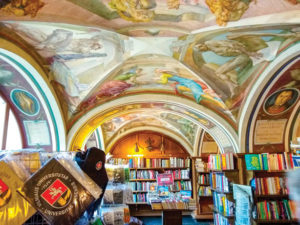
Prior to the Holocaust, about 100,000 Jews lived in Vilnius (nearly 45 percent of the population) making it a major center of Jewish culture. Today, there are 5,000. The Vilnius Choral Synagogue is the only synagogue in Lithuania to survive World War II, and its Romanesque-Moorish style, inside and out, is enchanting.
Vilnius University, founded in the 1500s, is Eastern Europe’s oldest. Nearly 20,000 students attend; seven times as many visitors drop in each year. The university attracts visitors — like us — in large part for its impressive courtyards, the library’s handsome bronze doors and the unusual “Seasons of the Year” frescos depicting Lithuanian folklore on the walls and ceilings of the Center for Lithuanian Studies.
The nearby Literatu Street is another destination for mural art. There, decorations celebrating Lithuanian authors (and authors of any nation who mention Vilnius in their work) adorn the outdoor walls. A local joked about one author who described Vilnius as a dark and terrible place — earning him a place of honor on Literatu Street.
Nation within a City
One last stop: Užupis, a community across the river that declared independence from Lithuania in 1997. Its constitution, posted in multiple languages, includes such articles as “everyone has the right to live” and “everyone has a right to die, but not an obligation.”
A backpacking Jesus statue greets hikers, murals color the walls, and art instillations fill the streets.
Whether the rest of the world takes Užupis seriously doesn’t matter, because the point of being a citizen of this republic is not to take yourself too seriously. In the beer hall — or Užupis Congress — we drank to our experiences on both sides of the river and agreed to carry the carefree spirit of the republic with us back to Baltimore.




